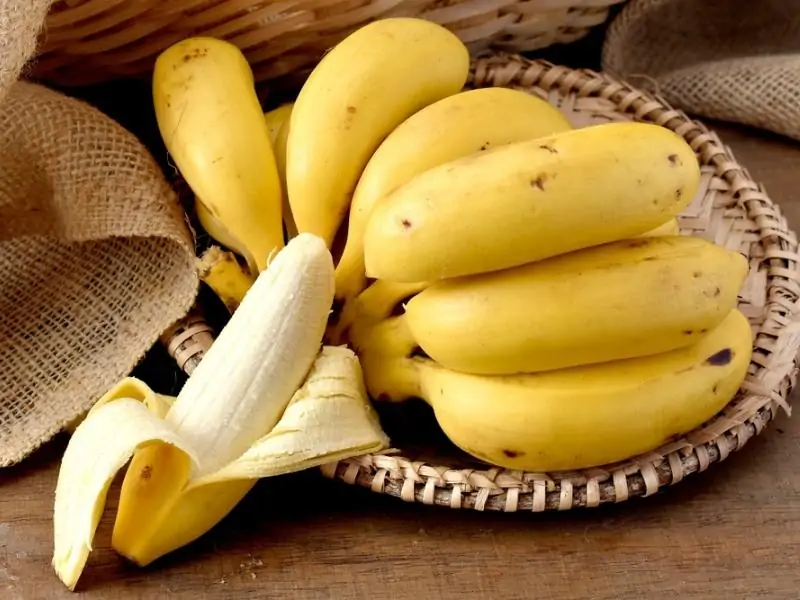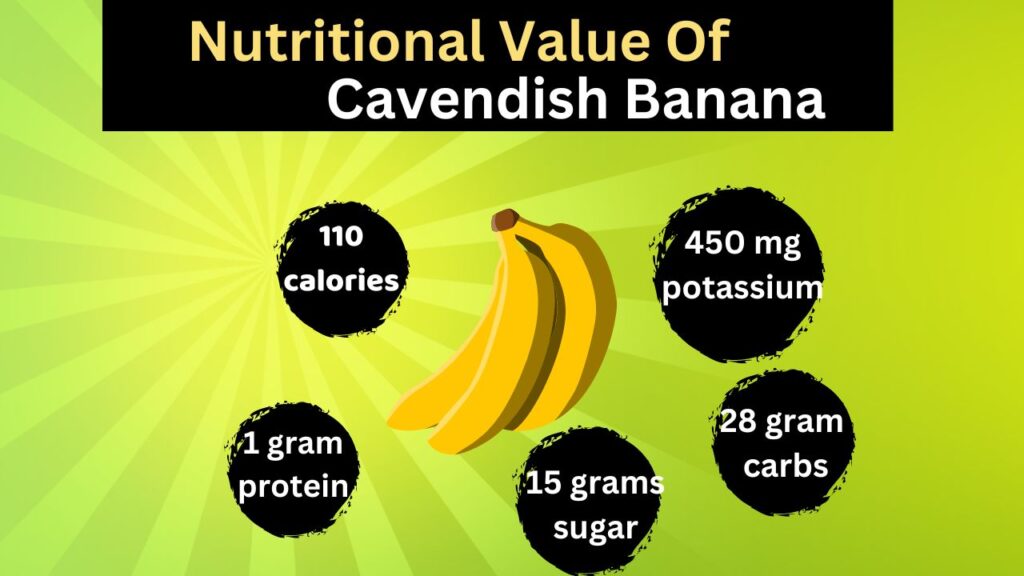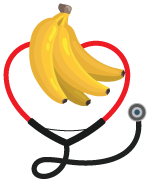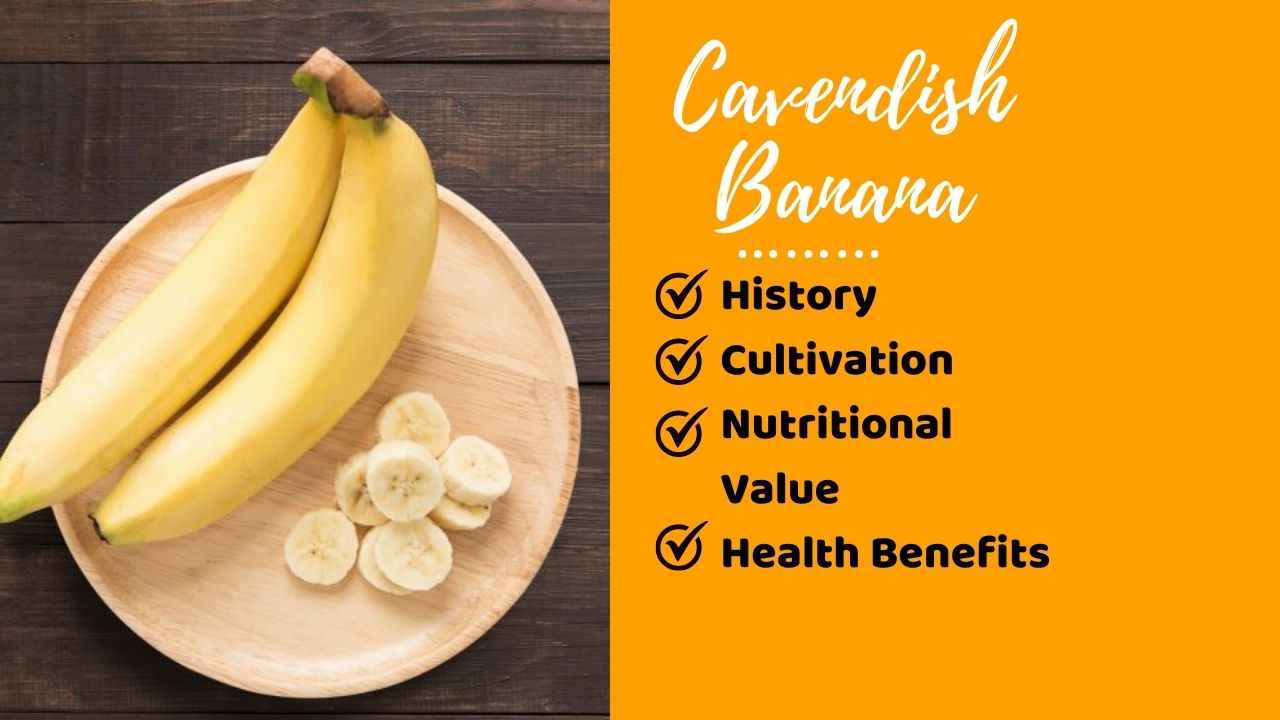Written By Sania Malik || Reviewed By Adeel Abbas
Cavendish banana is considered one of the sweetest and most popular varieties of bananas in the world. [1]
Cavendish bananas are the most common type of banana eaten in the world. They are a part of cultivar group, and are distinguished by their sweet flavor, yellow skin, and creamy flesh.
Cavendish bananas are grown in tropical and subtropical regions around the globe, and are available year-round.[2]

In this article, we will take a deep dive into the Cavendish banana, its history, cultivation, nutritional value, & health benefits.
Origin of Cavendish Banana
The Cavendish banana is named after Sir Henry Cavendish, a British scientist who discovered hydrogen. The banana variety was first cultivated in the 1830s in Mauritius, an island nation in the Indian Ocean.
This banana replaced the Gros Michel banana, which was popular in the early 20th century but became extinct due to a fungal disease known as Panama disease. [3]
Cultivation of Cavendish Banana
Cavendish bananas are grown in tropical regions around the world, including Asia, Africa, and Latin America. The banana plant is a herbaceous plant that grows up to 25 feet tall.
It produces large leaves and clusters of fruit called hands. Each hand contains up to 20 individual bananas. [4]
The cultivation process of these bananas involves planting the banana plant in well-drained soil and ensuring that it receives adequate water and sunlight.
The plant also requires regular fertilization and pest control. After 8-12 months, the banana plant produces fruit, which takes an additional 3-4 months to mature.
Nutritional Value of Cavendish Banana
- The Cavendish banana is not only delicious but also packed with nutrients.
- They are a good source of vitamins and minerals, including vitamin C, vitamin B6, potassium, and dietary fiber.
- One medium-sized banana contains approximately 105 calories, 27 grams of carbohydrates, and 3 grams of fiber.
- Bananas are also low in fat and sodium. [5]

Health Benefits of Cavendish Banana
Bananas are often touted as a healthy snack, and this banana is no exception. Here is some of the health benefits of banana associated with consuming this popular fruit. [6]
1: High in Nutrients
Cavendish bananas are packed with essential vitamins and minerals, including vitamin C, vitamin B6, potassium, and fiber.
They are also low in fat and calories, making them a great choice for those looking to maintain a healthy diet. [7]
2: Regulate Blood Sugar
Due to their high fiber content, these bananas may help regulates blood sugar levels.

The fiber in bananas slows down the absorption of sugar into the bloodstream, which can help prevent spikes in blood sugar levels. [8]
3: Improve Digestion
Bananas are known for their digestive properties, and the this type of banana is no exception.
They contain a type of fiber called resistant starch, which passes through the digestive tract without being broken down, helping to promote healthy digestion. [9]

4: Boost Heart Health
Potassium is an essential mineral that plays a key role in maintaining healthy blood pressure and heart function.
These bananas are a good source of potassium, making them a heart-healthy food choice. [10]
5: Improve Mood and Reduce Stress
Bananas contain tryptophan, an amino acid that the body uses to produce serotonin, a neurotransmitter that is known to improve mood and reduce stress levels.
Eating Cavendish bananas may help boost serotonin levels, leading to a more positive outlook. [11]
6: Support Exercise Performance
Bananas are often touted as a great pre- or post-workout snack due to their high carbohydrate content.
The carbohydrates in bananas provide energy for exercise, while the potassium helps prevent muscle cramps. [12]
Why is this Banana so popular?
The Cavendish banana is favored by many due to its sweet flavor, creamy texture, and convenience. It’s available all year round, making it a great snack or ingredient for various dishes. It’s also easy to peel and store, making it a go-to fruit for many. [13]
Fun Facts about the Cavendish Banana
- The banana is the most commonly grown banana variety in the world.
- Bananas are actually berries, not fruit.
- This type of banana is a sterile fruit, meaning it cannot reproduce on its own and must be grown from cuttings.
- This banana is named after the Cavendish family, who were prominent in English botany and horticulture. [14]
The Cavendish banana is a delicious and nutritious fruit that’s loved by many. Its sweet taste, creamy texture, and convenience make it a great snack or ingredient for various dishes.
Plus, its numerous health benefits make it a great addition to any diet. So, the next time you’re looking for a sweet and healthy snack, reach for a Cavendish banana.
FAQs
Are Cavendish bananas genetically modified?
No, Cavendish bananas are not genetically modified. They are a result of selective breeding.
Are Cavendish bananas better than other banana varieties?
Cavendish bananas are not necessarily better than other banana varieties. However, they are popular for their taste, texture, and availability.
Can I eat Cavendish bananas if I have diabetes?
Yes, but in moderation. Cavendish bananas are high in sugar and carbohydrates, which can raise blood sugar levels.
Can I eat the peel of a Cavendish banana?
The peel of a Cavendish banana is edible, it is not typically consumed due to its tough and fibrous texture.
How many bananas should I eat per day?
The recommended daily intake of bananas varies depending on factors such as age, sex, and activity level. However, most health experts recommend consuming 1-2 bananas per day.

